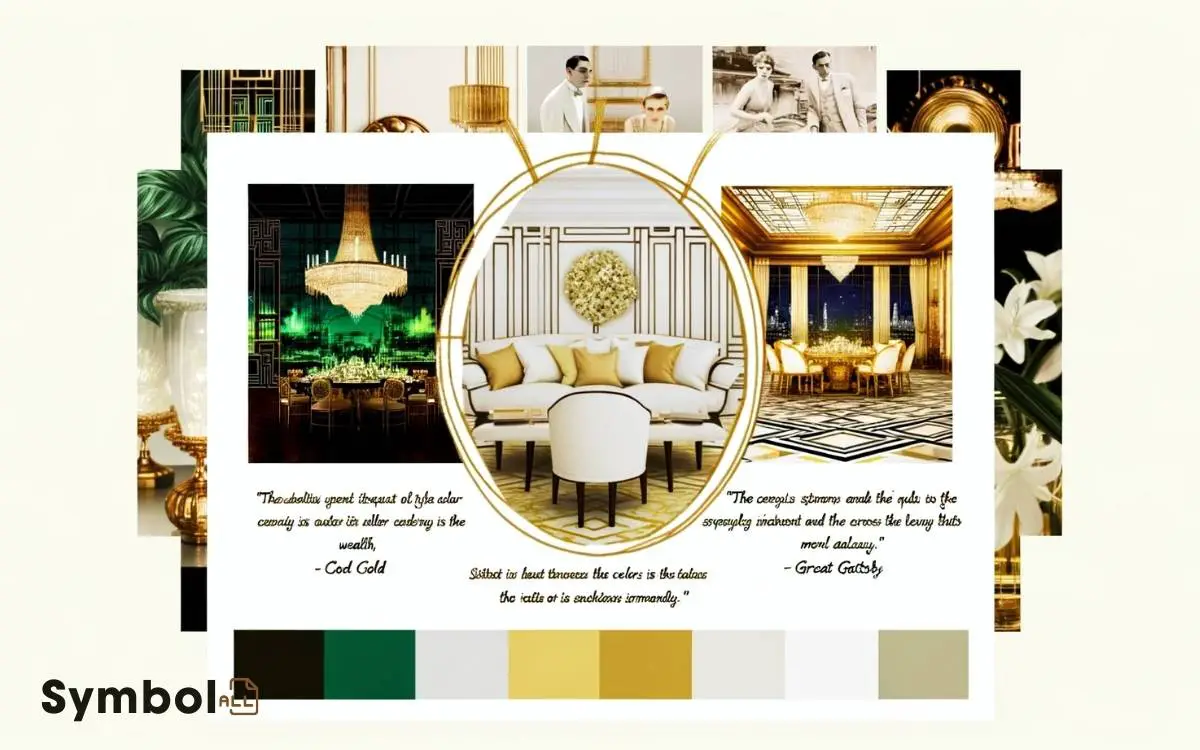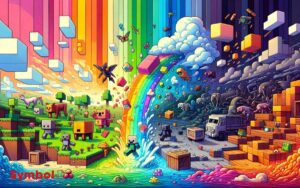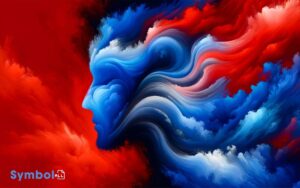Color Symbolism in the Great Gatsby Quotes: A Detailed Guide!
In ‘The Great Gatsby,’ color symbolism reveals the essence of ambition, deceit, and decay.
- The green light, embodying Gatsby’s unattainable dreams, contrasts with the gold that reflects the false allure of wealth.
- White, exuding purity, cleverly masks the characters’ selfishness, while yellow denotes the dark side of luxury.
- Blue offers a tranquil escape, hinting at deeper truths beneath the surface allure.
Each color weaves into the narrative, critically reflecting on societal values and individual desires. Understanding these symbols, you’ll uncover the layers of Fitzgerald’s critique on the American Dream and its implications, revealing more about the characters’ true colors.

Key Takeaway
Color Symbolism in “The Great Gatsby” Quotes –
| Color | Quote | Character | Chapter | Symbolic Meaning |
|---|---|---|---|---|
| Green | “Involuntarily I glanced seaward – and distinguished nothing except a single green light” | Nick Carraway | 1 | Hope and the American Dream |
| Yellow/Gold | “With the influence of the dress her personality had also undergone a change” | Daisy Buchanan | 7 | Wealth, money, and corruption |
| White | “Our white girlhood was passed together there. Our beautiful white—” | Daisy Buchanan | 1 | Innocence, purity, or false purity |
| Blue | “He had come a long way to this blue lawn, and his dream must have seemed so close” | Narrator | 9 | Illusion, fantasy, and the unreachable |
| Gray | “The valley of ashes is bounded on one side by a small foul river ash-grey men…” | Narrator | 2 | Decay, desolation, and the lifeless |
The Mystery of Green
In F. Scott Fitzgerald‘s ‘The Great Gatsby,’ the color green serves as a multifaceted symbol that intricately weaves themes of ambition, hope, and the elusive nature of the American Dream.
You’ll notice it’s not just any symbol; it’s a beacon of longing that reflects Gatsby’s deep yearnings for Daisy, a manifestation of his hope.
This color, vividly represented by the green light at the end of Daisy’s dock, embodies the infinite desire for what’s just out of reach, suggesting that the American Dream, in its purest form, is always a tad beyond one’s grasp.
Through this lens, Fitzgerald critiques the dream itself, suggesting it’s more about the perpetual chase than the actual attainment, leaving readers to ponder the true cost of such ambition.
The Illusion of Gold
Shifting focus from the verdant hues of hope, let’s explore how Fitzgerald uses gold to craft a compelling narrative on wealth’s deceptive allure and the moral decay it often masks.
The glittering gold represents not just wealth but an illusion of happiness and success that many characters in ‘The Great Gatsby’ chase after. It’s a mirage that often leads to moral compromise and, ultimately, emptiness.
- Gold symbolizes the facade of prosperity that characters project, hiding their true selves and desires.
- It underscores the emptiness of material wealth, showing that true happiness isn’t found in possessions or status.
- Fitzgerald critiques the American Dream, suggesting that the pursuit of wealth can lead to moral decay and personal ruin.
The Deception of White
In ‘The Great Gatsby,’ white misleadingly symbolizes purity and innocence, particularly through the character of Daisy.
You’ll notice that Daisy frequently adorns herself in white, projecting an aura of innocence that masks her true selfishness and carelessness.
This deceptive use of white not only underscores her character’s duplicity but also reflects the overall theme of moral decay hidden beneath the surface of the Jazz Age’s glittering facade.
Whites False Purity
White, often symbolizing purity and innocence, paradoxically masks the moral decay and superficiality of characters in ‘The Great Gatsby.’ F. Scott Fitzgerald masterfully employs white to mislead the reader, initially projecting a facade of purity. As the narrative unfolds, the color white meaning in The Great Gatsby transforms, revealing the hollowness hidden beneath its pristine exterior. Characters like Daisy Buchanan, often associated with white, appear angelic and virtuous but embody selfishness and moral emptiness. Through this stark contrast, Fitzgerald critiques the deceptive allure of outward appearances in the pursuit of the American Dream.
However, as you investigate further, it becomes evident that this color is a smokescreen for the characters’ corruption and emptiness.
- White as a facade: It’s not just about physical appearances but also about the deeper moral bankruptcy it hides.
- Contrast and contradiction: The stark contrast between the symbol of white and the characters’ actions offers a critical commentary on the era’s hypocrisy.
- Superficial purity: White’s frequent use emphasizes the superficial nature of the societal elite’s morality and values, urging a deeper exploration beyond appearances.
Daisys Innocence Illusion
Building on the notion of white’s false purity, let’s examine how Daisy Buchanan’s portrayal embodies this deception, casting a shadow over her perceived innocence.
Fitzgerald cleverly dresses Daisy in white to symbolize purity and innocence, yet her actions reveal a stark contrast.
She’s entangled in affairs, lies, and moral ambiguity, indicating that the white veil she wears is nothing but a facade.
This juxtaposition serves as a critical commentary on the era’s superficial values, where appearances often masked the true, corrupt nature of society and its individuals.
Daisy’s character becomes a vessel through which Fitzgerald exposes the illusion of innocence, suggesting that beneath the surface of societal purity lies a complex, flawed human reality.
Her white-clad persona deceives not only other characters but also us as readers, urging a deeper look beyond appearances.
The Danger of Yellow
Yellow, often perceived as a symbol of wealth and luxury in ‘The Great Gatsby,’ subtly harbors a sinister undertone, signaling danger and moral decay.
This color, which initially appears opulent and inviting, gradually reveals its association with deceit, betrayal, and death.
Fitzgerald masterfully employs yellow to caution you about the corrupting power of wealth and the superficial allure of the American Dream.
- Yellow cars symbolize reckless affluence, leading to tragic outcomes, reminding you that unchecked materialism often ends in disaster.
- Gold versus yellow distinction underscores the genuine versus the facade, prompting a reflection on true values versus superficial appearances.
- Yellow lights and decorations often precede moments of moral failure, subtly warning that all that glitters isn’t gold, especially in a world obsessed with appearance.
These elements collectively underscore the peril lurking beneath the surface of prosperity.
The Serenity of Blue
In contrast to the sinister undertones of yellow, blue emerges throughout ‘The Great Gatsby’ as a symbol of tranquility and hope, offering a serene reprieve from the chaotic pursuit of the American Dream.
Notice how Fitzgerald uses blue to envelop moments of calm and reflection, distancing his characters momentarily from their relentless desires and ambitions.
The blue of the sky and the ocean hints at a world of possibilities beyond the materialistic confines of their existence. It’s a reminder of the purity and peace that can exist, albeit fleetingly, in their tumultuous world.
Through this use of blue, Fitzgerald isn’t just painting a picture; he’s weaving a complex emotional landscape, inviting you to see beyond the glittering surface to the tranquil depths beneath.
The Violence of Red
Fitzgerald masterfully uses red as the embodiment of violence and passion, drawing you into a world where desire and danger intertwine. This vivid hue saturates scenes of intense emotion, signaling both allure and warning.
In Gatsby’s universe, red isn’t just a color; it’s a harbinger of the tumultuous consequences stemming from unchecked desires.
Red symbolizes the raw, unfiltered essence of life’s most powerful forces, both creative and destructive. It serves as a visual cue, foreshadowing the inevitable collision between the characters’ passions and the harsh realities they face.
The manipulation of red highlights the thin line between love and aggression, underscoring the complexity of human emotions and relationships.
The Despair of Grey
While red captures the intensity of passion and violence, grey brings us into a domain of disillusionment and existential despair, offering a stark contrast in the emotional landscape of ‘The Great Gatsby.’
In this narrative, grey isn’t just a color; it’s a symbol of the void between dreams and reality, the fog of uncertainty clouding the characters’ futures.
The Valley of Ashes, a grey wasteland, embodies the decay of the American Dream, a place where hopes are ashen and spirits are crushed under the weight of industrialism and moral decay.
It’s here you see characters trapped in a cycle of desolation, their lives tinted with the hue of hopelessness.
Grey, then, isn’t merely a color—it’s the embodiment of the novel’s critique on the erosion of societal values and the personal cost of pursuing the unattainable.
The Symbolism of Silver
As you explore the symbolism of silver in ‘The Great Gatsby,’ you’ll notice its association with wealth is unmistakable, representing both opulence and the elusive nature of the American Dream.
This color also mirrors the era’s fascination with modernity, reflecting the novel’s setting in the Roaring Twenties, a time of technological advancements and cultural shifts.
Yet, silver’s emotional coldness underscores the superficiality and isolation experienced by the characters, offering a critical view of their materialistic world.
Silvers Wealth Connotations
In ‘The Great Gatsby,’ silver’s opulence not only signifies wealth but also reflects the elusive, often intangible nature of the American Dream.
Its presence throughout the novel subtly underscores the characters’ pursuit of wealth as a means to achieve their desires, yet it also hints at the hollowness and impermanence of their achievements.
Silver, unlike the more traditional gold, suggests a modern, almost ethereal wealth that can vanish as quickly as it appears, mirroring the fleeting nature of success in the Roaring Twenties.
Silver symbolizes the transient quality of wealth, emphasizing its temporary and often illusory status.
It adds a layer of sophistication and allure, attracting characters to the glittering, yet ultimately unfulfilling, pursuit of material success.
Reflects the novel’s critique of the American Dream, highlighting the disparity between appearance and reality.
Silver and Modernity Link
Silver’s embodiment of modernity within ‘The Great Gatsby‘ serves as a beacon, illuminating the novel’s exploration of new wealth and its impact on societal values and individual identities.
This color, often associated with sleekness and innovation, mirrors the era’s rapid technological advancements and the burgeoning allure of the new, wealthy class.
Through Fitzgerald’s meticulous use of silver, you’re invited to reflect on the characters’ fascination with the present’s glimmering possibilities, distancing themselves from the past’s traditional constraints.
It’s not just a color; it’s a symbol of the time’s optimistic pursuit of progress and the seductive charm of the Jazz Age, encapsulating the characters’ desires to redefine their lives amidst the shimmering allure of modernity.
Silvers Emotional Coldness
Delving deeper into the symbolism of silver in ‘The Great Gatsby,’ one can’t help but notice its portrayal of emotional coldness, reflecting the characters’ internal voids and the superficiality of their relationships.
This color, often shimmering and ethereal, mirrors the shallow veneer of the society Fitzgerald depicts, where genuine connections are as elusive as the metallic sheen of silver.
- Silver’s coolness mirrors the characters’ detachment: It’s a visual cue for the emotional distance and alienation they feel from one another.
- Reflects the era’s materialism: Silver symbolizes wealth and technological progress, yet it underscores the lack of warmth and genuine happiness.
- A metaphor for empty promises: Like the deceptive allure of silver, the characters’ pursuits and relationships are ultimately unfulfilling, highlighting the hollowness at the heart of their glittering world.
The Innocence of Pink
Pink, often associated with innocence and purity, plays a pivotal role in ‘The Great Gatsby,’ subtly weaving through the narrative to highlight characters’ naivety and the fading dream of untainted love.
It’s not just a color; it’s a symbol of the delicate fantasies that permeate the lives of those within the story.
When you encounter pink within the novel, it’s as though Fitzgerald is inviting you to peer beneath the surface glamor, to the untouched hopes and dreams lying beneath.
This use of pink isn’t merely decorative; it’s deeply intentional, marking moments where the veneer of sophistication cracks, revealing the raw, unadulterated desires for love and acceptance underneath.
It’s a reminder that beneath their jaded exteriors, the characters yearn for a simplicity and purity they can never truly reclaim.
The Contrast of Lavender
You’ll find that lavender carries a dual meaning in ‘The Great Gatsby,’ symbolizing both opulence and decay.
Through symbolic lavender moments, Fitzgerald contrasts the superficial beauty of the Jazz Age with its underlying corruption.
This analysis will guide you through the nuanced portrayal of society’s facade versus its reality, embodied by the color lavender.
Lavenders Dual Meaning
In F. Scott Fitzgerald’s ‘The Great Gatsby,’ lavender serves as a symbol of both opulence and melancholy, showcasing the novel’s rich tapestry of dual meanings.
This nuanced use of color enriches the narrative, providing depth to the characters and their environment. You’re invited to explore the layers beneath the surface of Gatsby’s glittering world.
- Opulence: Lavender signifies luxury and the extravagance of Gatsby’s parties, hinting at the wealth and excess that define the Roaring Twenties.
- Melancholy: Beyond the glamour, lavender also reflects the underlying sadness and longing that permeate the novel, symbolizing the characters’ unfulfilled desires and the ephemeral nature of their joys.
- Dual Meanings: The contrast within lavender itself mirrors the characters’ complex relationships and the illusory quality of the American Dream.
Symbolic Lavender Moments
Exploring the symbolic lavender moments in ‘The Great Gatsby’ reveals the stark contrast between opulence and melancholy, further enriching our understanding of the novel’s intricate themes.
You’ll find lavender not just as a physical presence but as a metaphorical one, weaving through the narrative to highlight the disparities within the characters’ lives and their surroundings.
| Aspect | Opulence | Melancholy |
|---|---|---|
| Presence | Lavender suits at Gatsby’s parties | Fading lavender light in the evening |
| Emotion | Elation and extravagance | Loneliness and longing |
| Symbolism | Wealth and fantasy | Loss and unrealized dreams |
This contrast underscores the tension between reality and illusion, guiding you through the emotional landscape of the story.
Lavender, as a result, becomes a lens through which you can discern the true essence of the characters’ experiences and the societal commentary Fitzgerald crafts.
The Opulence of Purple
Delving into F. Scott Fitzgerald’s ‘The Great Gatsby,’ the color purple emerges as a symbol of wealth and decadence, capturing the essence of the era’s opulence.
This vivid hue permeates the narrative, subtly weaving through scenes to underscore the extravagance and the superficial glamour that defines the lives of the characters.
Fitzgerald uses purple not just as an aesthetic detail but as a narrative device that enriches the story’s thematic concerns.
- Showcases social status: Purple’s association with royalty and luxury underscores characters’ desires for a higher social standing.
- Highlights the divide: It also marks the stark contrast between the opulent lives of the wealthy and the bleak existences of the less fortunate.
- Symbolizes moral corruption: The lavishness associated with purple often masks the moral decay festering beneath the surface.
The Ambiguity of Brown
You’ll find that brown’s role in ‘The Great Gatsby’ isn’t as straightforward as you might think. It can signify both stability and decay, a duality that reflects the novel’s complex themes and characters.
This color’s ambiguity challenges you to contemplate the nuanced ways Fitzgerald uses symbolism to deepen the narrative.
Browns Complex Interpretations
In the domain of ‘The Great Gatsby,’ the color brown harbors a multitude of interpretations, weaving through the narrative with a complexity that demands attentive analysis.
This color subtly pervades the story, often overlooked, yet it holds layers of meaning that contribute to the unfolding drama and character development.
- Brown’s earthiness can symbolize a grounding reality amidst the glittering excesses that define the novel’s setting.
- It might also reflect the blurring of moral lines, embodying the murky waters of Gatsby’s ambitions and the societal decay Fitzgerald critiques.
- Brown’s association with the mundane contrasts sharply with the vivid colors of wealth and opulence, highlighting the stark disparities between characters’ aspirations and their actual circumstances.
Understanding these nuances enhances your appreciation of Fitzgerald’s masterful use of symbolism, offering a richer reading experience.
Symbolizing Stability or Decay
Within the pages of ‘The Great Gatsby,’ brown’s symbolism oscillates between representing stability and decay, revealing the nuanced duality of Fitzgerald’s world. You’ll notice this ambiguity deeply woven into the narrative’s fabric.
Brown surfaces in the valley of ashes, a place teeming with life’s ephemerality, hinting at decay and desolation.
Yet, it also appears in the sturdy, earth-toned attire of characters who embody resilience and traditional values, suggesting a grounding stability.
This duality prompts you to ponder the precarious balance between enduring traditions and the inevitable decline they face amidst modernity’s relentless march.
Fitzgerald cleverly employs brown to underscore the impermanence and reliability coexisting in the American Dream, inviting you to explore the complexity of human aspirations and the reality that shadows them.
The Clarity of Black
Delving into ‘The Great Gatsby,’ it becomes evident that black symbolizes the profound, often overlooked clarity within the chaos of the novel’s high society.
Black, often associated with darkness or mourning, surprisingly serves as a beacon of truth amidst the dazzling colors of Gatsby’s world. It represents the stark reality underlying the facade of the lavish lifestyles and the inevitable consequences of the characters’ actions.
- Contrast: Black starkly contrasts with brighter hues, emphasizing the superficiality of Gatsby’s glamorous life.
- Sobriety: It signifies the sobering truth behind the characters’ hedonistic pursuits.
- Finality: Black foreshadows the inevitable downfall and the harsh outcomes of the characters’ choices.
Through black, Fitzgerald subtly conveys the clarity and inevitability of truth, reminding readers that amidst life’s vibrant distractions, reality eventually prevails.
The Purity of Ivory
Turning our attention to ivory, it’s clear that this color embodies the purity and innocence that subtly permeate the chaotic tapestry of ‘The Great Gatsby,’ offering a stark contrast to the novel’s darker themes.
Fitzgerald cleverly uses ivory to represent not just social status and wealth, but also the illusion of purity within certain characters and settings.
It’s as if ivory acts as a beacon, highlighting the characters’ yearning for a simpler, untainted existence amidst their morally grey lives.
However, this color also serves to underscore the ultimate unattainability of such purity in the novel’s corrupt setting.
Through Fitzgerald’s nuanced use of ivory, you’re invited to ponder the complexity of innocence in a world where appearances can be deceiving, urging a deeper reflection on the true nature of purity.
The Reality of Orange
After exploring the symbolic purity of ivory in ‘The Great Gatsby,’ let’s now examine how orange, a color often overlooked, reveals the novel’s complex reality.
Orange, blending the passion of red with the joy of yellow, embodies the novel’s nuanced portrayal of ambition and the pursuit of happiness. It captures the essence of Gatsby’s dreams, tinged with the harsh reality of his ultimate demise.
- Orange symbolizes the vibrant, yet ephemeral, nature of Gatsby’s aspirations.
- It reflects the illusion of prosperity and the inevitable decay beneath the surface.
- This color illustrates the blend of optimism and corruption, mirroring the complex social dynamics of the era.
Understanding orange within the novel deepens your appreciation of Fitzgerald’s mastery in using color to convey thematic intricacies.
Conclusion
As you’ve journeyed through the vivid tapestry of colors in ‘The Great Gatsby,’ each hue reveals a deeper truth about the characters and their world.
From the green light symbolizing unattainable dreams to the deceptive purity of white, Fitzgerald paints a complex picture of desire and disillusionment.
The colors, rich with symbolism, weave a story that’s as enthralling as it’s tragic. In this kaleidoscope of emotions and themes, the true colors of Gatsby’s world, and perhaps our own, are disclosed.






